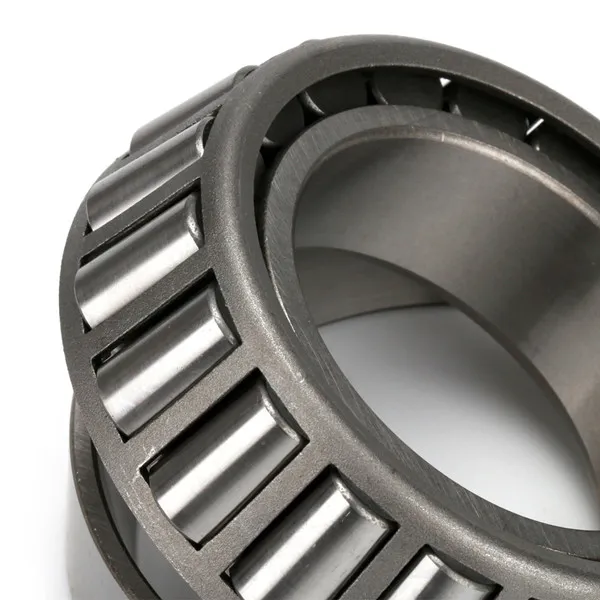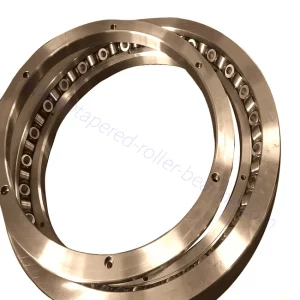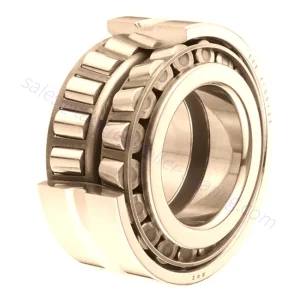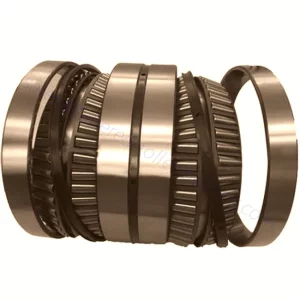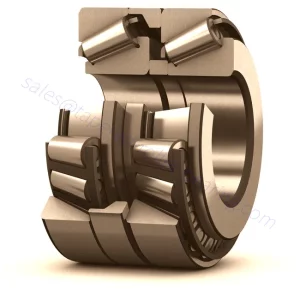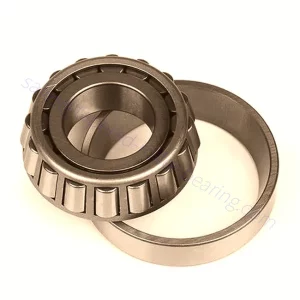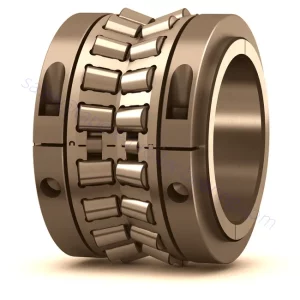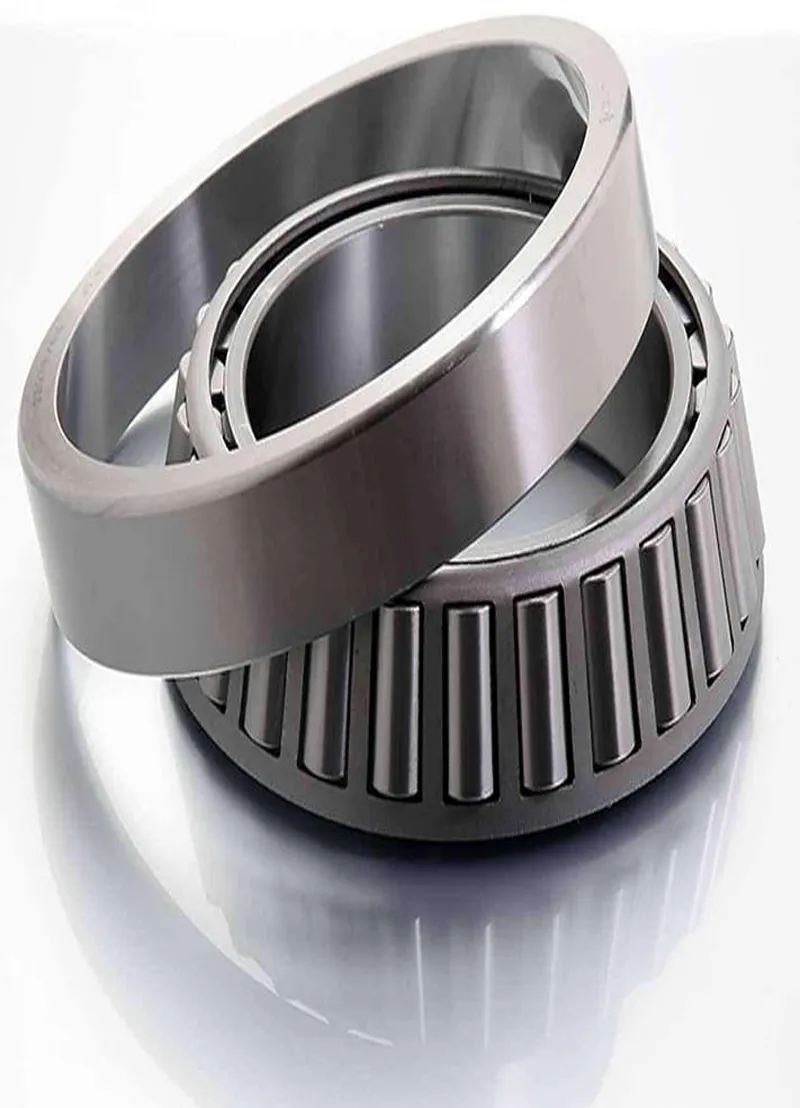Tapered Roller Bearing
Tapered roller bearings are available in a variety of designs and can also be customized for your specific speed, load, contamination, temperature or vibration conditions.
Tapered Roller Bearing
Tapered Roller Bearing Components
Tapered roller bearings have unique design characteristics compared to other roller bearings. The rollers themselves have end diameters of two different sizes, hence the name “tapered rollers.” The raceways in which the rollers operate have an angled surface corresponding with the taper of the rollers, which makes these rings resemble segments of a cone; the inner raceway is called a cone, while the outer raceway is known as a cup. A cage separates rollers, also referred to as a retainer, and keeps the rollers a fixed distance apart, ensuring a smooth rotation and even load distribution.
Rollers
Axial and Radial Loads
The angle formed by the line of contact between the cup and rollers and that of the bearing’s bore axis determines the type of load for which the bearing is well-suited. The larger the angle, the better the bearing is able to handle thrust loads, but the capacity to handle radial loads is proportionally reduced.
Cages
The Pin Cage
The most common type of cage implemented is the pin cage. Two differently-sized rings are machined, one of which has a series of pins that extend from its circumference and upon which the rollers are threaded. The other ring is welded to the ends of the pins to contain the rollers and cage in a unified assembly.
Seals
Bearing Seals
Bearing seals are an effective way of preventing the bearing from being impeded by various environmental contaminants and moisture. Contact seals are those which increase friction, due to the fact that rubberized or polyurethane seal components experience some sliding against the rotating bearing.
Bearing
Featured Products
Tapered roller bearings are separable bearings. Both the inner and outer rings of the bearing have tapered raceways. This type of bearing is divided into single row, double row and four row tapered roller bearings according to the number of columns of rolling elements.
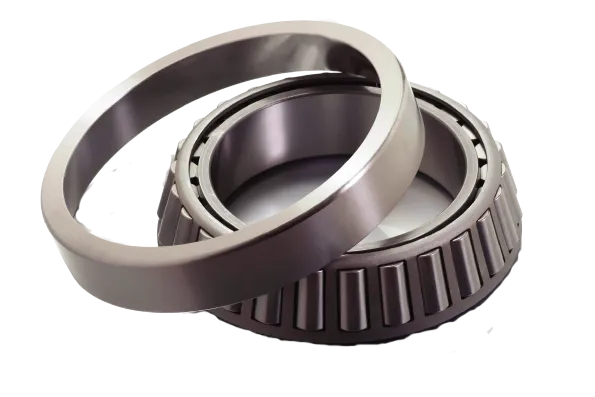
Tapered Roller Bearing
Key Features of Tapered Roller Bearing
The tapered roller bearing is designed so that the apex of the tapered face on the raceway face of the cone cup intersects with a single point on the bearing centerline. Suitable for applications with heavy load and impact load.
Low friction
The roller end face and the baffle are optimally designed, and the baffle guide surface is polished to reduce its roughness, thus promoting the formation of lubricating oil film and reducing friction.It also reduces the wear of the retaining edge.
Long service life
Optimized design of the outer surface profile of the rolling element with convexity or logarithmic curve shape can optimize the load distribution between the contact surface of the raceway surface and the rolling element.
Improve reliability
The raceways and surface profiles of tapered roller bearings are finely machined, which facilitates the formation of a lubricating oil film during operation, thereby increasing the reliability of the bearing.
Easy to install
Tapered roller bearings are easy to install because they have separable, interchangeable bearing parts that make installation, removal and maintenance easier.
Application of Tapered Roller Bearings
There are several applications in a heavy-duty truck that use tapered roller bearings.Wheel End – Tapered roller bearings are found in the wheel ends of your heavy-duty truck. They are used in steer axles, drive axles, pusher axles, tag axles, and trailer wheel ends. Most of these designs use an inner and outer tapered bearing, but there are a few truck models that use a cartridge or hub unit design.

Tapered Roller Bearing Specifications
We are one of the top Tapered Roller Bearings manufacturers in China. Precision machines, experienced engineers and staffs back up our commitment to continuously produce and develop high quality Tapered Roller Bearings.
Lifespan
This standard estimates the bearing life, based on 90% reliability for all roller bearings, and accounts for variables such as materials, manufacturing quality, types of load, operating conditions, lubrication, and contamination.
Speed
The temperature of the bearing largely dictates the operational speed. Reference speed is the speed at which the heat generated and dissipated by the bearing is at equilibrium.
Deflection
Deflection will occur between the tapered rollers and the raceways; specifically the ends of the rollers may adopt a more elliptical shape. Tapered roller bearings deflect less than many other types of bearings
Temperature
Thermal expansion of bearing components is inevitable, but excessive heat can be relieved by the lubricant, materials and construction of the raceways, cages, and rollers, and overall surface areas.
Torque
Bearing torque can be attributed to several variables, such as roller size, the number of rollers, cage composition, bearing tolerances, lubricant type and fill, and the bearing’s load.
Lubrication
While the potential for the sliding or scrubbing of rollers in this type of bearing is considerably less than other types of bearings, lubrication helps reduce the friction between rollers and raceways.


difference and contrast
Tapered Roller Bearing vs Cylindrical Roller Bearing
(1) Bearing capacity: When cylindrical roller bearings have no ribs or retaining rings, they can only bear radial force; tapered roller bearings can bear radial force and axial force, but they are generally used in the form of bearings with a double row or more rows.
(2) Running speed: The speed of single row cylindrical roller bearings is the best. Whether they are double row cylindrical roller bearings, cylindrical roller bearings with single ribs, or cylindrical roller bearings with retaining rings, their limiting running speeds are faster than tapered roller bearings.
(3) Accuracy: Generally, the accuracy of single-row and double-row cylindrical roller bearings is better than that of single row tapered roller bearings. Compared with other types of bearings, cylindrical roller bearings and tapered roller bearings have lower accuracy.
(4) Noise: Among them, the single row cylindrical roller bearing has the lowest noise.
FAQ
Some FAQ
1. What are the common causes of excessive bearing temperature?
(1) Poor lubrication, such as insufficient or excessive lubrication, the quality of the lubricant does not meet the requirements.
(2) Insufficient cooling, such as blocked pipes, improper selection of coolers, and poor cooling effect.
(3) The bearings are abnormal, such as bearing damage, poor bearing assembly process, and the clearance adjustment of each part of the bearing box does not meet the requirements.
(4) The vibration is large. For example, if the coupling process is not correct, the rotor will have dynamic, static imbalances and poor foundation stiffness.
Commonly used bearings in vehicles represented by motorcycles and automobiles are starter motor bearings, crankshaft bearings, gearbox bearings, and wheel hub bearings. According to the operating conditions of the starter motor, specific requirements are put forward for the bearing’s ability to withstand intermittent impact loads, and at the same time, it must have good dust-proof performance and select a reasonable internal bearing clearance. The wheel hub bearing has a high speed and a large force, which requires the use of suitable grease, and the internal design of the clearance is relatively large, which puts forward higher requirements for the production of raw materials. The force and working conditions of automotive ball bearings are more complicated than those of motorcycles. For example, the bearing of the automobile condensing fan motor should take into account the continuous working condition of the motor under high-temperature conditions and so on.
(1) Energy-saving heat treatment of roller bearings. Select new thermal insulation materials to improve the energy utilization rate of heat treatment equipment; optimize the heat treatment process, increase the process output, and give full play to the capabilities of the equipment.
(2) Precision heat treatment of roller bearings.Precision heat treatment is to fully guarantee the stability of the optimized process. The product quality dispersion of roller bearings is very small (or zero), heat treatment distortion is zero, grinding allowance is reduced, production efficiency is improved, and materials are saved.
(3) Non-oxidative heat treatment of roller bearings.From the use of protective atmosphere heating instead of oxidizing atmosphere heating to controlled atmosphere heating with precise control of carbon potential and nitrogen potential, the performance of the parts after heat treatment is improved.
(4) Cleaning and heat treatment of roller bearings.The waste water, waste gas, waste salt, waste oil and electromagnetic radiation formed by heat treatment will cause pollution to the environment. To solve the environmental pollution problem of heat treatment, the implementation of clean heat treatment (or green heat treatment) is one of the development directions of heat treatment technology.
